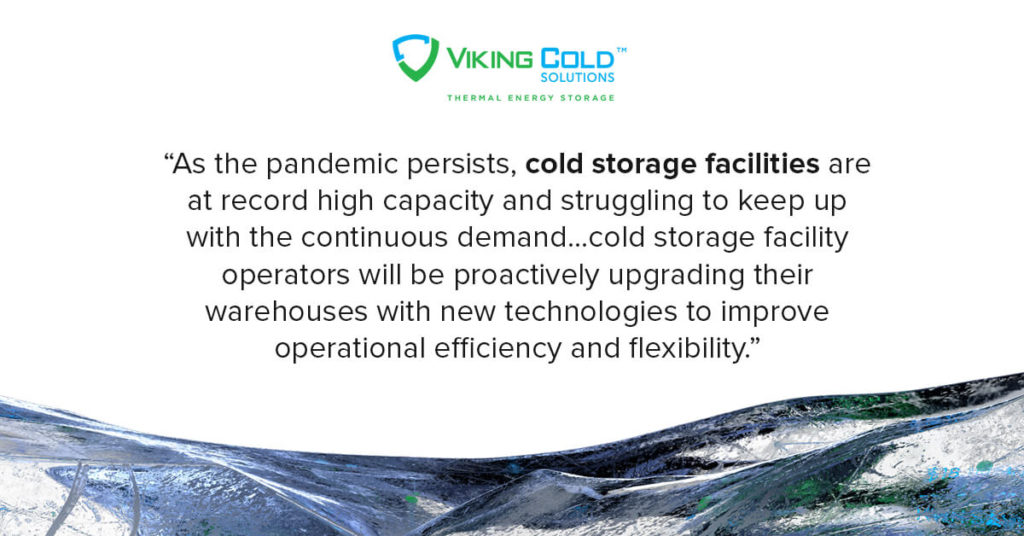The coronavirus pandemic has greatly disrupted the U.S. food industry, resulting in significant changes in consumer behavior and an increased demand for industrial cold storage warehouse space. With quarantines still in effect around most of the country, consumers have been forced to eat at home more and either “panic-buy” large quantities of extra groceries and/or shift to more online orders more frequently. Additionally, because of its longer shelf-life and surge in available options, the frozen food category has seen significant growth in both online and in-person grocery purchases, forcing grocery and cold storage facilities to scramble to keep up.
According to the American Frozen Food Institute (AFFI), seven in 10 frozen food shoppers have increased the amount of frozen food they’re buying since the start of the pandemic. Six months in, U.S. shoppers are continuing to stock up their freezers with frozen meals, meats, ice cream, and frozen novelties. Not only is the number of consumers purchasing frozen food growing, but many have also switched to ordering directly online from restaurants and foodservice distributors. The question is: How has this rapidly changing behavior affected the cold storage industry – an essential element of our supply chain dedicated to protecting, delivering, and handling temperature-controlled goods in the United States.
Warehouse demand, in general, has been accelerating in recent years, largely due to the booming e-commerce industry. The world’s largest commercial real estate services and investment firm, Coldwell Banker Richard Ellis (CBRE), examined the relationship between e-commerce grocery growth and cold storage warehouse capacity in its 2019 “Food on Demand Series: Cold Storage Logistics Unpacked” report, forecasting that in order to meet the demand generated by online grocery sales, an additional 75 to 100 million sq. ft. of industrial freezer and cooler space will be needed within the next five years – an increase of roughly 47%. CBRE researchers also suggest that much of the cold-storage sector’s growth is likely to occur in gateway markets like Los Angeles and the New York area, as well as in top food-producing states such as California, Texas, Wisconsin, Florida, and Washington state.
As the pandemic persists, cold storage facilities are at record high capacity and struggling to keep up with the continuous demand. Cold storage facilities typically fall into the categories of public refrigerated warehouses (PRWs), foodservice and wholesale, grocery distribution centers and retail stores, and food processing facilities. Due to changing demand, PRWs have been forced to provide smaller, more frequent orders. National food industry news source, The Food Institute, stated that “Instead of supplying a full pallet of a single product to a warehouse, PRWs are now delivering a pallet with multiple products directly to the store. These small orders increase labor requirements and change transportation options drastically.” Many expect major PRWs to accelerate the industry’s consolidation trend in order to gain more control over the United States’ cold storage footprint.
It is also expected that to address the changing market, cold storage facility operators will be proactively upgrading their warehouses with new technologies to improve operational efficiency and flexibility. Warehouse upgrades that are seeing a surge in popularity include technologies such as Viking Cold Solutions thermal energy storage (TES), warehouse management systems (WMS), and material handling automation and robotic systems. The intelligence platform of Viking Cold’s TES system not only optimizes temperatures and energy use, but provides valuable, actionable data that allows operators to make operational improvements.
Additionally, there has been a growing interest in sustainable, carbon-reducing technologies. Viking Cold’s thermal energy storage systems also address these needs by increasing refrigeration energy efficiency an average of 26% while better protecting food and improving temperature resiliency. By absorbing and consolidating up to 85% of the heat infiltration, TES also allows refrigeration systems to be safely cycled off for up to 13 hours each day to avoid demand or time-of-use energy fees, while maintaining stable temperatures. The technology leverages existing refrigeration systems and easily integrates with controls, other data platforms, and racking structures to bring efficiency, flexibility, and additional food protection to the frozen food chain.
The COVID-19 pandemic has accelerated changes in consumer behavior, implementation of technology, and broad market trends in the food industry. The entire distribution chain from food processors to logistics companies to retailers is under added pressure to make improvements to stay profitable and keep food on our tables. The future remains unclear but enabling technologies like Viking Cold’s TES are helping the food and beverage industry feed our families by improving operations, cutting costs, and lowering the GHG emissions of refrigeration.


